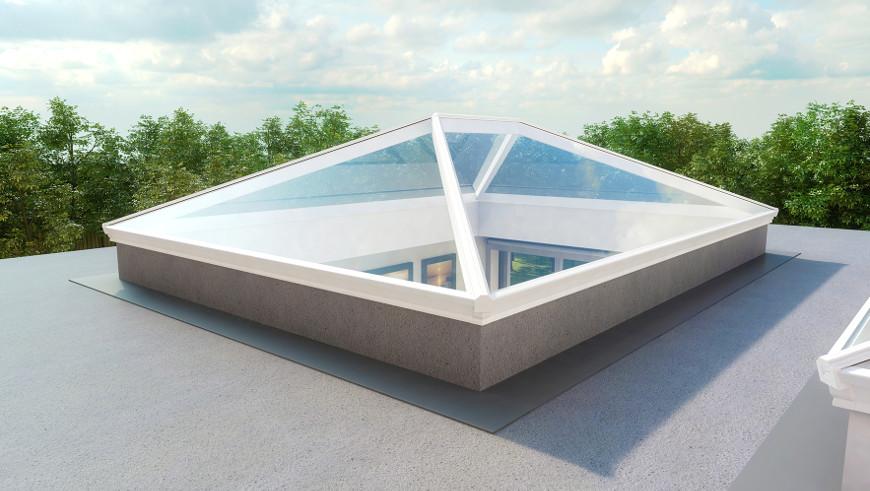Roof Lantern Installation Cost
Last updated 10th June, 2025
Thinking about a flat roof lantern?
This article discusses the costs involved with installing a roof lantern. We look at the supply costs and the roof lantern installation prices.
Keep reading below for more information!

Table of Contents
How Much Does a Roof Lantern Cost?
The average roof lantern installation cost in the UK is around £2,600 and will take around 2-3 days to complete. Although this is based on a 1500mm x 1500mm basic roof lantern, as prices can vary on the size and design.
Roof lanterns were once highly fashionable in the Victorian and Georgian era, but today they are making a comeback and have become an affordable and efficient way to add some extra natural light to your home.
Architects are now pushing roof lanterns as they are relatively straightforward to install and pose few problems in terms of building regulations and planning permission.
Roof Lantern Prices
A good-quality medium-sized timber-framed roof lantern of around 3m x 3m will typically cost around £4000 fully installed. Whereas a smaller (around 750mm x 750mm) uPVC framed lantern can be installed for around £1,700. For any additional costs, expect to pay £700 for a ventilator and anything from £1000 to £4000 for bespoke blinds, although please note these are not included in any installation costs quoted elsewhere within this guide.
Due to the scale and time involved for the project, the cost of a tradesperson's time and labour can be quite high, particularly for more specialist/complex jobs or for larger scale installation.
Below are some estimated costs of installation for roof lanterns, without including the additional costs of blinds or the fitting of a ventilator.
| Job Description | Avg. Cost | Duration |
|---|---|---|
| 750mm x 750mm roof lantern | £1700 | 2 Days |
| 1500mm x 1500mm basic roof lantern | £2600 | 2-3 Days |
| 1500mm x 3000mm roof lantern | £3250 | 3 Days |
| 3000mm x 3000mm roof lantern | £4000 | 4 Days |
Roof Lantern Cost Breakdown Calculator
Individual costs to install an average 1500mm x 1500mm basic roof lantern: £2600
Materials
£1170
Tradesmen
£1430
Waste Removal
£0
Additional Roof Lantern Costs
If you already have a flat roof, then introducing a roof lantern may require some additional structural work during the installation. Likewise, it will need careful sealing to avoid leaks and it may require planning permission before you start.
If it's time to replace your flat roof anyway, which can cost between £700 and £1,300, then it could be a good time to budget for the additional work.
Alternatively, if you're in the process of saving for a house extension then factor a roof lantern into the budget.
However, this is potentially just the start of your developments. The roof lantern could also be included as part of a kitchen extension or maybe you've recently added sliding or bifold doors (£2,000 to £,6000) and wish to make your room even more bright and spacious.
That's not to mention other jobs that also come with home renovations, such as plastering or painting and decorating.
A roof lantern can dramatically enhance the appearance of a property, as well as having the practical appeal of allowing more light into the room. They are often more suited to a flat roof, such as an extension, and are available in a wide range of shapes and styles, everything from small domes or pyramids.
uPVC vs Timber Roof Lanterns
Roof lanterns can greatly improve the look of a home and they are usually made from either uPVC or timber frames combined with highly thermally efficient glass.
They are great for adding huge amounts of natural light, they're also environmentally friendly, can add value to your property and look great too. As for choosing uPVC or timber frames, we take a look at both options below:
uPVC Roof Lantern Frames
Affordable and low-maintenance, uPVC frames are a practical installation choice for modern roof lanterns.
Pros
- ✔ Budget-friendly compared to timber options
- ✔ Quick and simple to install due to lightweight design
- ✔ Designs suit modern or traditional new-builds
- ✔ Virtually maintenance-free and easy to clean
Cons
- ✖ Not as strong or durable as timber options
- ✖ Potential to expand or warp in extreme temperatures
- ✖ Limited colour options can make it less appealing
- ✖ Designs doesn't always suit older properties
Timber Roof Lantern Frames
Wooden timber frames provide a classic, natural look albeit while requiring regular upkeep.
Pros
- ✔ Timeless, elegant and aesthetically pleasing
- ✔ Excellent insulation and thermal efficiency
- ✔ Naturally strong and durable when treated
- ✔ Can be customised with timber choice and finish
Cons
- ✖ Higher initial cost compared to uPVC
- ✖ Susceptible to damage, including rot if not treated
- ✖ Therefore requires maintenance and painting or staining
- ✖ Heavier than uPVC, so may require additional structural support
As for which you decide to have installed, it ultimately uPVC roof lanterns are more affordable and low-maintenance, whereas the rewards for the upkeep of timber frames offer a premium, timeless appeal.
Roof Lantern vs Glass Conservatory
Roof lanterns are a practical, affordable and stylish solution for brightening up a flat-roof extension - whereas glass conservatories provide a striking, fully glazed living space, but comes at a higher cost.
Below we compare the pros and cons of each.
Roof Lantern Pros and Cons
Pros
- ✔ More affordable than a full glass conservatory
- ✔ Easier and quicker to install with fewer planning requirements
- ✔ Ideal for modern flat roof extensions, with no excessive heatloss
- ✔ Can be fitted with blinds or solar reflecting glass for higher efficiency
Cons
- ✖ Restricted viewing compared to all-glass conservatory
- ✖ Can compromise privacy in overlooked areas
- ✖ Design may not be suitable for all properties
Glass Conservatory Pros and Cons
Pros
- ✔ Provides maximum daylight and outdoor views
- ✔ Enhances a sense of a wider, more open space
- ✔ Ideal for socialising in the warmer months
- ✔ Adds seamless connection with the ouside spaces
Cons
- ✖ More expensive to build plus higher maintanence costs
- ✖ Requires planning permission and to meet regulations
- ✖ Difficult to maintain regular temperature levels
Planning Permission and Building Regulations
Modern roof lanterns almost always fall within your permitted development rights and they comply with all current building regulations, but you should always check with your local planning department to be sure.
Roof lanterns can make good financial sense as the light that comes into the building will save on electricity bills so the lantern will often pay for itself over the long term. Most roof lanterns will also have one or two opening panes for proper ventilation when required.
Discussing implementing a roof lantern with an experienced and professional designer/installer could be the best home improvement decision you make. But you do really need a professional for this sort of job as it is beyond the skills of most DIY enthusiasts.
So, if you want to add some additional light to your home with stunning looks then get in touch with a local specialist so they can help you to transform your home. It is possible to install a roof lantern yourself but you would have to be very confident indeed in your DIY skills and would have to liaise with Building Control to ensure the lantern complies with all building regulations.










